Are you in the market for a new pasta extruder? Perhaps you want to make homemade pasta – fresh pasta at home. Well today, I’m gonna be telling you all about my experiences using the KitchenAid Pasta Extruder set and some of the pros and cons as well as some of my tips for how to use it.
What’s in the box of Kitchenaid Pasta Extruder
If you’ve ever had fresh pasta, you may have noticed that it goes better with certain sauces than others. But again, that may be personal preference. That is one of my reasons for making my own fresh pasta at home, as opposed to always using the dried kind. And that’s exactly one of the reasons why I got this pasta extruder set.
As you can see here this is pretty much all that it comes with. And it doesn’t take up too much space. So in terms of what you get in the box, you can get a little plastic push thing/wrench, which you’re gonna need because the little bottom piece does get stuck on the bottom and I’ll be telling you more about that in a bit.
But in terms of what it comes with, that’s essentially it – you’re gonna get six little extruders. I guess molds if you want to call them that or shapers, you’re gonna get spaghetti, bucatini – which has a little hole in the center – rigatoni as well. Those are the fat pasta tubes. You’re gonna also get some large macaroni, and then also fusilli, which is the little spiral-shaped pasta. And then the bucatini and then the last one is small macaroni.
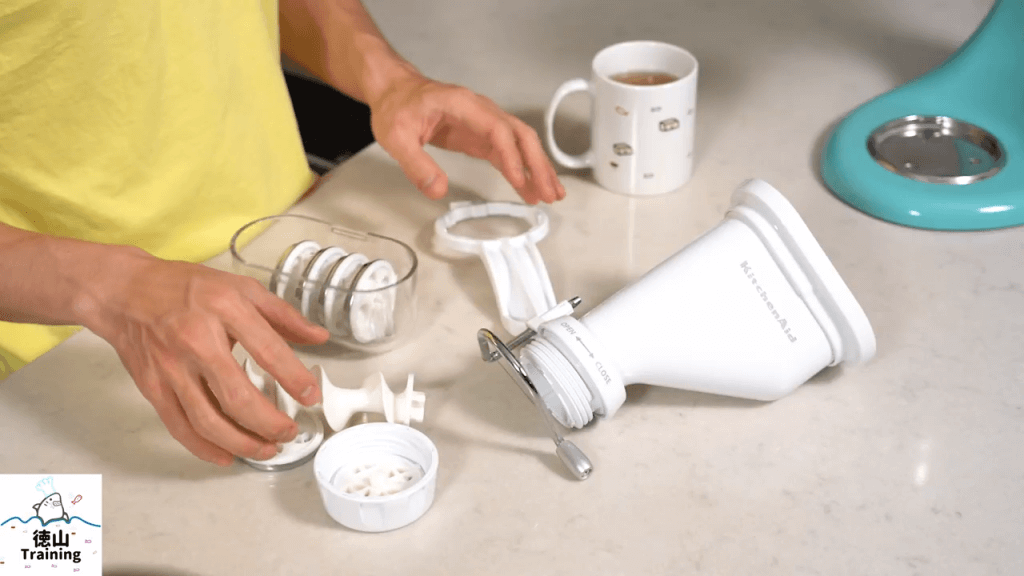
How to use the kitchen aid pasta press
The way that you would use it is pretty straightforward.
Whenever you decide you want to make spaghetti, for example, all you’re going to do is put the little end piece in the bottom part and then it will put this little “pusher” – it looks kind of like a drill in here. And there’s actually a little cross where this gets set in. You’re just gonna go ahead and put it in like that.
Make sure that it is set into the cross so you can see that it’s all the way in because it’s flush with the top and then you’re gonna put the cap on and the cup aligns like that with the bottom piece, the cutter, and you’re going to screw it on super tight – as tight as possible. You can use the wrench to tighten it but I usually just use the wrench to take it off. And then all you have to do is attach it to your stand mixer and then put in the dough. The dough goes in the top part right there and that’s essentially it.
If you have a KitchenAid stand mixer and some attachments, it’s pretty much the same as any other attachment. You just attach it on there and then put the screw back in so it stays in place. You turn it on and then it’ll start to extrude. Basically, when I’m ready to make my pasta or extrude the pasta with the KitchenAid gourmet pasta press, I’m gonna put this speed all the way to a ten.
This is the Artisan KitchenAid stand mixer, so it doesn’t have that much power. I think it’s like 350 watts. And because of that, I’m actually upgrading to a bigger stand mixer, which is gonna have 1.3 horsepower. That’s one horse and a third of a horsepower. It’s gonna be way stronger than this little thing. We’ll do a test and compare the results of each of those in a future video, of course. But that’s essentially it in terms of using it.
Once the extruded pasta comes out basically once you get the desired length – say you want to get one 12 inches of pasta – all you have to do is cut it with a stroke. And this is a pretty firm steel wire, so it’s gonna cut it pretty quickly and then you just leave it and then you let it go out again to how long that you want it and then you cut it again.
But the important thing when you do that is you got to make sure that it’s lined up because if you don’t line it up correctly, you’ll find that the steel thread there is gonna block some of the holes where the pasta is supposed to come out and then it’s gonna cause a clump and then it’s gonna get deformed. So you got to pay attention to that especially if you’re not used to using it – and that’s one tip that I have for you!

Cons of Kitchenaid Pasta Extruder
First, I really do not like cleaning this because it gets very messy, especially on the bottom part here. The bottom piece actually gets difficult to remove and I think that’s probably why they included this wrench to help you remove it.
There are little grooves here where you can do that. Where you can align the wrench notches with the cap and the issue that I have is that the pasta dough gets stuck. It gets stuck not only in between the threads but it makes its way up these threads (and on both the cap and then the body itself). Then there’s always pasta that’s stuck in the center.
There’s like a little hole here, which is what’s supposed to align with this little cutter, the extruder. And because of that, pasta always gets in because it’s not flush. And by the time you’re done with pasta making, you’ll find that there’s always going to be a little bit that’s stuck on this bottom part. That’s kind of annoying.
The second con is that it is wasteful because you’re always going to be wasting probably about a tablespoon to two tablespoons of extruded pasta dough because it doesn’t get pushed out because there’s nothing to push it out.
The third thing is that it’s all made of plastic mostly, including the cutting pieces. Yes, the frame is made of stainless steel but the actual pieces that are cutting the pasta and shaping it are made of plastic. Ideally, these would be extruded using bronze dies because, as you may know, bronze dies tend to give pasta an irregular surface which helps to deliver more flavor and more sauce to your mouth with each bite.
That’s one of the reasons why you would want bronze dies, but I don’t know why KitchenAid didn’t do that. I think that would be nice to have a bronze die extruder set. Maybe that’s something that they can consider in a future update for this.
So the fourth con is that this thing gets really noisy. So like I said, the Artisan is only about 350 watts in terms of power, and you can really hear the motor straining when it’s extruding the pasta. Like I mentioned, when you have this thing attached, and you’re putting the dough on the top, you’re going to push it down. And if you have the same model as mine, you may notice that it’s going to start to strain and it’s going to slow down, you know how this little thing will start to turn.
So when you turn it on you can see that it’s going at a regular pace. But when I have it at full speed at 10, it’s going to have a whirring sound. And then when you start to push the dough in, it’s going to have a slow whirring sound. It’s gonna slow down because it’s not strong enough to handle the extrusion or it’s not strong enough to force the pasta through these little holes. If you have a stronger stand mixer, as I mentioned, that may not be an issue for you.
And then the fifth, which was really surprising to me because I actually thought that the extruder would be simpler, easier to use, less fussy than the actual cutting set.
I also had the cutting set which I’ll be reviewing in another video. The KitchenAid pasta roller and cutting set, which you used to make fettuccine as well as spaghetti and flat pasta like lasagna. That one is actually, in my opinion, a little bit easier to use.
You have to keep feeding it for one thing, and then you have to keep cutting it as well. So the pasta roller cutting set does the cutting for you.
It’s a little bit less work in my opinion, and you don’t have to keep feeding it little balls, little dough balls which is what they recommend. That’s another thing to keep in mind.
Pros of using Pasta Press
One is that it’s pretty simple to use. As I mentioned, all you gotta do is attach it you got to put the dough in and out will come your pasta. It doesn’t get any easier than that.
The second thing is that it does include a lot of different shapes of pasta. If you’re into experimenting with different shapes, or trying different shapes and enjoying them, this will give you some of that freedom to do so.
This being a KitchenAid pasta attachment, it does work with any KitchenAid stand mixer that has a little front thing – the little hole where you can attach things to. That’s a plus right there (third pro).
So the fourth pro that I think you might want to think about is it helps you make fresh pasta. If you didn’t have one of these KitchenAid pasta attachment sets, what you’d have to do is either do it manually, using one of those crank machines where you have to crank the pasta out by hand, which would take you much longer.
I guess I don’t think there is a manual extruder, at least that I’ve seen, so that would be your only option, I guess.
The fifth pro is that it doesn’t take up too much space. As you can see this is pretty much all that it comes with; there was a cap for this thing so I don’t know where I put it, but this thing doesn’t take up too much space.
Essentially it and it works. I guess that would be the sixth pro, it works!
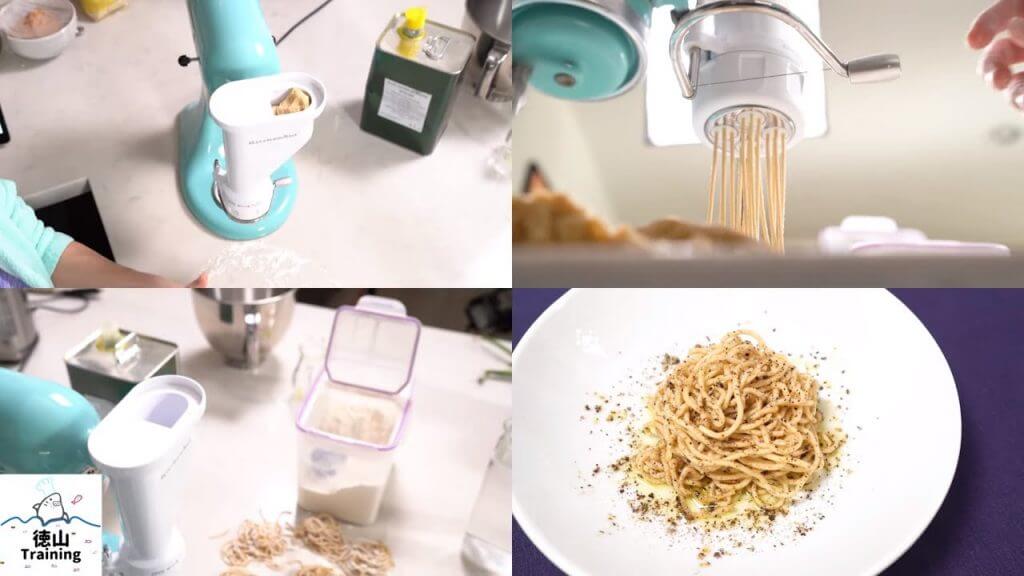
Five Tips for using this particular pasta extruder set to help you get started:
1. Use the recipes that the book or that it came with when you get this little attachment set. It’s going to come with a little manual and then in that manual, there’s going to be extruder pasta dough recipes. Use those recipes first so that you get a feel of the kind of dough, the texture and the consistency, the feel of it, for the particular extruder set.
2. Try to experiment with not only different types of flour but different ingredients, like vegetables or even herbs. I like to put tomato and spinach for example into my pasta, as well as basil or even shiso. You can try different combinations of flour such as semolina flour and all-purpose flour, as well.
I got a grain mill earlier this year to help me with my home-baked bread and also my fresh homemade pasta. And with that, if you have your different types of flours that can give you different types of flavors, different textures and consistencies that you can also experiment with. So that’ll keep you pretty busy and excited to play with this, as well. So that’s another tip.
3. When you’re putting the dough in, you want to use very small balls that fit into the hole, and you also want to push it down so that the machine or the stand mixer is pushing out as much as possible. You may notice that it starts to speed up when it’s not feeding or it’s not extruding and that’s when you know that you need to push it down more.
4. Make sure they use a lot of flour like so that the pasta, once it’s cut and extruded, doesn’t stick to each other, or the pieces don’t stick to each other.

On top of that, if you’re not going to be using flour – which I don’t know why you wouldn’t because you should be using flour – you should get some sort of a pasta drying rack. The KitchenAid Drying Rack opens up and so you can hang it on here to dry while doing another batch of pasta, for example, or if you want to save it for later on. I definitely recommend getting one of these or some of the other products that are available. But this is the one that I use and I like it. I think it works very well. It’s very functional and it has enough space for about three pounds of pasta.
5. Make sure that you’re using high speed on the mixer. The ten on the Artisan model, not sure how fast I’m gonna have to do it on the pro line when I get it, but I’ll let you know when I play with it. Make sure that when you do cut your pasta that you have the little wire aligned properly.
[embedyt] https://www.youtube.com/watch?v=cj_qf2DR3tA[/embedyt]



Konnichiwa! (Hello!) I'm Pat Tokuyama, a Japanese tofu cookbook author, who travels for music, food, and adventure. If you like Japanese tea, checkout some of the newestorganic japanese tea, matcha bowls and noren and more!
** Curious about the Plant Based Japanese Cooking Club? ** Learn more here!
Conclusion
Whether you’re a seasoned pasta maker or a beginner, using an extruder is a fantastic way to create unique and delicious pasta shapes in the comfort of your own home.
But wait, there’s more! The Kitchenaid (KPEXTA) Stand-Mixer Pasta-Extruder is another type of pasta extruder that’s worth mentioning. This attachment allows you to create six different pasta shapes, including bucatini, fusilli, and large or small macaroni. The possibilities are endless with this versatile extruder.
And if you’re feeling adventurous, why not try making homemade pasta for Soba Noodles, Creamy Mentaiko Pasta, or Homemade Bucatini with Fresh Herbs and Zesty Breadcrumbs.
So, grab your extruder attachment or stand-mixer pasta extruder, get creative with your dough, and enjoy the delicious results!
Question of the day: Have you ever made fresh pasta before? or if you haven’t made it yet, maybe, have you tasted fresh pasta, and you know exactly how awesome and delicious it can be?
Let me know in the comments below right now, and what kind of pasta sauce you had that experience with, or what kind of pasta sauce you would be interested in trying your freshly homemade pasta with.


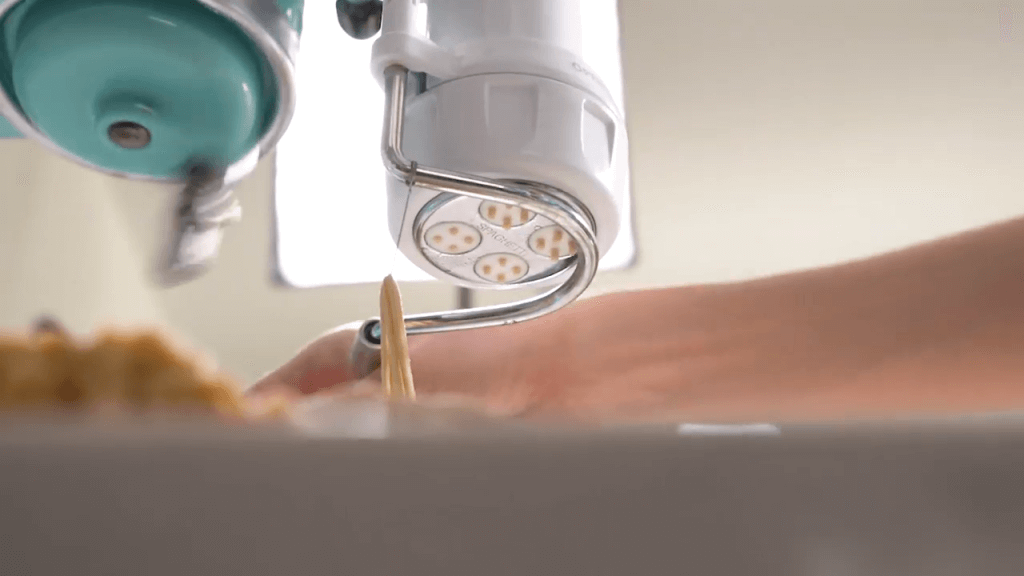
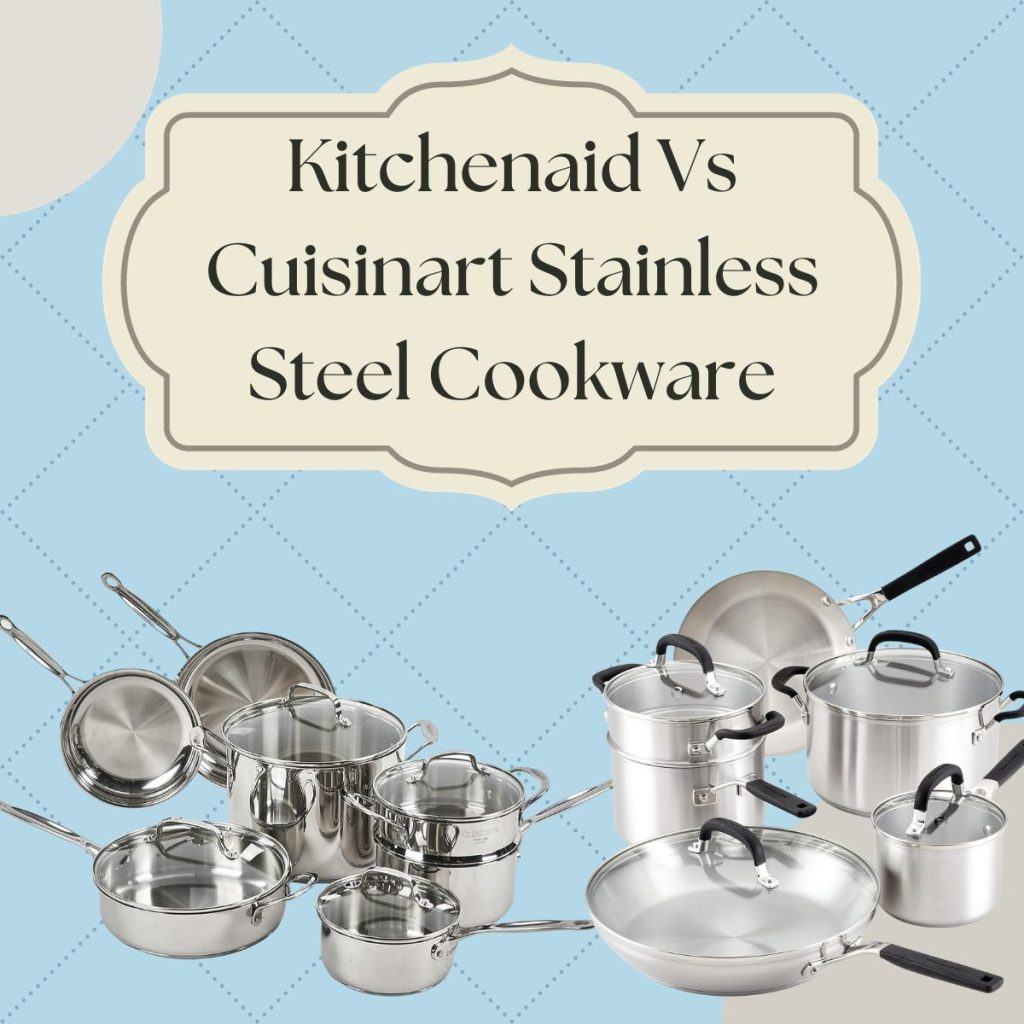
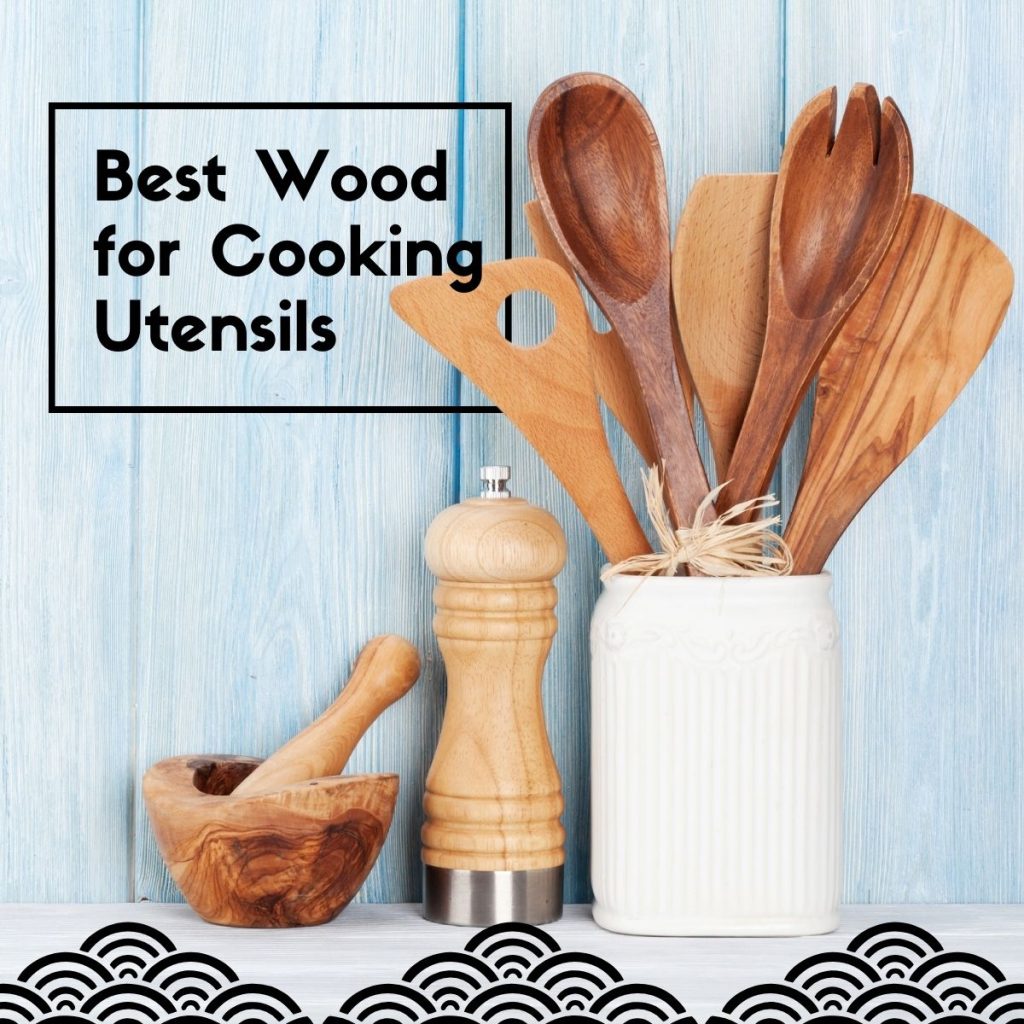

Konnichiwa! (Hello!) I'm Pat Tokuyama, a Japanese tofu cookbook author, who travels for music, food, and adventure. If you like Japanese tea, checkout some of the newestorganic japanese tea, matcha bowls and noren and more!
** Curious about the Plant Based Japanese Cooking Club? ** Learn more here!